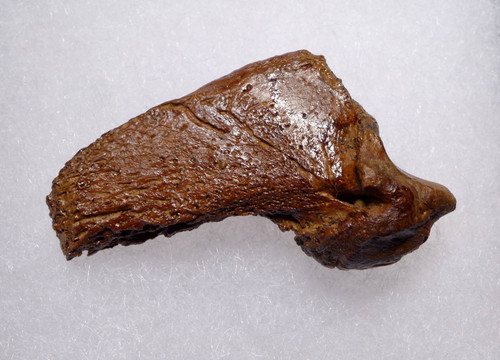Product Description
This is a FINEST QUALITY genuine fossil claw from the extinct giant Cave Bear, Ursus spelaeus of Europe. Not only is this complete claw of impeccable preservation, it is MORE RARE than claws from Romania's Carpathian Mountain deposits as it is from the famous Dragons Cave (Drachenhohle) in Austria. For many decades, the world famous Dragons Cave (Drachenhohle) in Austria has been closed and protected as an international prehistoric site, forbidding any modern collecting. This specimen came from a 50+ year old private Dutch collection. The cave got its name around the turn of the last century when locals dug the cave floor for a resource of fertilizer from the large build-up of bat dung over the centuries. In the course of digging, many cave bear bones were discovered but since the cave bear was extinct and not known about at the time, villagers believed the bones to be from dragons, hence the name. The site is an enormous cave and has been closed and protected for some time. You cannot even enter the cave without a tour guide today. The collection of cave bear fossils we acquired were collected over 50 years ago prior to existing laws. Fossils from this cave are RARE on the market, and no other cave in the world is known so famously for its cave bear fossil deposits as this site.
This claw has been treated with a chemical hardener to protect its fragile nature. It would make an impressive collection fossil from this rare site, but also as an amazing focal or accent piece in a unique jewelry creation or talisman.
HISTORY
Drachenhöhle or Drachenhöhle Mixnitz (literally Dragon's Cave of Mixnitz) is a 542 m (1,778 ft) long cave with a 20 m (66 ft) wide and 12 m (39 ft) high entrance near Mixnitz, Styria, Austria, south-east of Bruck an der Mur located at an elevation of 950 m (3,120 ft) above sea level. Cave bear of the species (Ursus ingressus), and other bone fossils that people found during the Middle Ages were deemed to be the bones of dragons, a belief that culminated in the saga of the "Dragon slayer of Mixnitz". The cave is one of the largest caves in the Alps where bears occupied an area that stretched over a length of way over 500 m (1,600 ft), by an average width of up to 40 m (130 ft) and a height of 10 to 15 m (33 to 49 ft).
Due to a shortage of fertilizers during and after World War I the 8 to 10 m (26 to 33 ft) high sediments inside the cave were intensively mined between 1918 and 1923 of which around 2,500 tons of phosphoric acid were extracted. During the fertilizer mining, several geologists and paleontologists were present, who only documented the most valuable discoveries. Nonetheless, a rich cache of cave bear, Eurasian cave lion (Panthera leo spelaea), Gray wolf (Canis lupus), Alpine ibex (Capra ibex) and Alpine marmot (Marmota marmota) fossils, remains of open hearths and Paleolithic stone tools of the Aurignacian culture dated to 65,000 to 31,000 BCE were unearthed. Dated to between 65,000 and 31,000 BCE, these rank among the oldest traces of human presence in Austria.
 US DOLLAR
US DOLLAR
 EURO
EURO
 AUSTRALIAN DOLLAR
AUSTRALIAN DOLLAR
 CANADIAN DOLLAR
CANADIAN DOLLAR
 POUND STERLING
POUND STERLING














